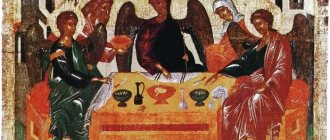Usually, when people are called brothers, they mean blood relationship. Of course, we are not talking about gangster “brothers”. But in Rus' there were other options, that is, not only kinship by blood, but also many other fraternal ties, no less strong.
Read in the material who were called foster brothers, how stepchildren, half-brothers and half-children differed, how one could become cross-brothers and what principles numerous religious brotherhoods had.
Customs of the people, family traditions. What is this?
Do we and our families need them?
Giving a serious definition to the word tradition, we are talking about the totality of the connection of times between generations through the transmission of centuries-old experience... and so on.
A bit boring. Do you agree?
Such definitions and formulations are more suitable for scientific works, various studies, and explanatory dictionaries. But without such research and a scientific approach to the study of family, family values and traditions, you “can’t go far.”
Family traditions and customs come to us from grandfathers and fathers.
This is interesting: books are your horizons and level of intelligence!
In simple terms, we understand that the emergence of traditions in society, and family traditions, is facilitated by the simple transfer of knowledge. The vast experience of our ancestors shows what is bad and what is good.
Thanks to the information of generations, we know how to arrange our lives - and sometimes we ourselves make improvements to family traditions. We remember sin and honor the memory of those who have passed on. We rejoice at the birth of a new life and teach the younger ones to rejoice in this.
This creates a strong family, and therefore a strong society. Respect and reverence become not just words, but a certain ritual, the core of human behavior. Love for the homeland and one’s family in the minds of people takes on the meaning of ceremony, that is, tradition.
If the traditions of each family, and therefore the traditions of society as a whole, stand in the minds of the people above their laws, then a wonderful, worthy future awaits this nation.
Drank bread wine instead of vodka
Bread wine (polugar) is a strong alcoholic drink that our ancestors consumed before the invention of vodka. It was made by distilling grain mash. Wine is called bread wine because cereals are used for its preparation: rye, barley, wheat, buckwheat, etc.
By the way, in terms of production technology, bread wine is no different from whiskey.
Family traditions in Rus'
Striving for complete and unconditional independence, young couples want to have separate housing and live away from their parents. Why? Of course, this is the spirit of the times. Below we will reveal several reasons for this. And now, let’s plunge a little into the history of Rus' and consider several interesting and, at times, surprising ancient Russian family traditions.
This is interesting: Sex and marriage in the ancient world. Interesting and unusual facts
In Rus', several families lived under one roof. How do you understand - several families? It's simple: the children grew up, got married and remained to live under the same roof with their parents, while running a joint household.
So:
♦ Such a family enjoyed universal respect throughout the entire district, in the region. The words “home” were taken very seriously and went along with the concepts of “conscience”, “homeland”, “mother and father”. A person without a family was called an offended god and a bastard.
♦ The most interesting thing: simple swearing in the house, as well as envy, were considered a great sin.
♦ Important matters were decided at family councils, where there were even small children. They began to imitate adults. Learned obedience.
There were fist fights
Fist fights took place in the winter during the Shrovetide period. Two villages could fight with each other, residents of opposite ends of one large village, “monastic” peasants with landowners, etc. They also prepared for battles very seriously, for example, the men steamed in the baths, tried to eat more meat and bread, which, according to I believe they gave me strength and courage.
Such a massacre allowed one to relieve tension and let off steam.
About modern family values and traditions in Russia.
Russia is a multinational country and is proud of it. The Russian people have always honored and honor the memory of their ancestors. For a Russian person, family and Motherland always remain the main value.
True, over the last two decades, it was the Russians who began to lose their family traditions - in the sense that the Russians began to lose their identity
Russian customs and Russian pastimes began to be forgotten.
And there are two reasons that contribute to this:
first - a sharp division of society into rich and poor,
second - strong globalization of society
What manifestations of globalization do we see in our society today? :
♦ the appearance of a large number of foreign words in the Russian language;
♦ introducing “foreign” holidays and traditions into the consciousness of Russians;
Be sure to read: Old age and longevity. How to slow down your aging?
♦ filling store shelves with cheap goods with the theme of foreign habits and customs;
♦ erasing boundaries between nationalities. There is a mixture of races and languages;
Magic holiday
With the advent of Christianity in Rus', new holidays appeared, but pagan rituals were still preserved in Russian traditions. It’s just that from then on they harmoniously integrated into Orthodox holidays. Christmastide remains among the most mysterious and interesting holidays.
This period lasts from January 7 to January 19. It is called the time of fortune telling and divination. In the old days, on Christmastide, cattle were slaughtered, gatherings were held with guests, and sweet uzvar was made, which was treated to relatives.
But perhaps the most interesting Christmas tradition is fortune telling. Even today, Russian girls often gather on these magical days to ask fate about their future. And several centuries ago, a variety of rituals were held on Christmastide.
Konstantin Makovsky “Yuletide fortune-telling”, 1890 Location: State Museum of the History of Religion, St. Petersburg, Russia
With the help of a shoe or felt boot thrown over the gate, they determined in which direction the groom lived. To predict the future, girls poured wax into a dish of water, burned a thread, or looked in a mirror. Of course, one may not believe in such “magic,” but a significant part of these fortune-telling has survived to this day.
Russian traditions represent a huge part of their original and vibrant culture. Even the Russians themselves do not know all the customs that their ancestors observed. In addition, each region of Rus' had its own rituals and traditional holidays. Many customs can surprise foreigners, but they contain the depth and richness of the beliefs of a truly great people.
A little more about family traditions. Russian traditions in proverbs
To all of the above, I would like to add a few words about the attitude towards family traditions.
Dear readers, the most important thing is to have traditions in the family! And then - your preferences, emotional impulses and desire - to be one friendly and cheerful family.
Let's say a common meal. It doesn’t matter whether there is a reason or not, whether you are preparing some super meatballs or huge manti, whether you are celebrating some kind of family holiday or celebrating the birthday of an African baby elephant - the main thing is like-mindedness, positive communication, love and kindness.
Hug each other more often with or without reason. Kiss when parting and meeting, wave to each other and send air greetings.
read, smile and laugh: humor in family life
Be sure to show sincere and constant concern for your grandparents. Remember, someday you will become the same! May at this age return to you as much and even more goodness than you gave to your family.
Don't forget about the old generation. The true truth is in the proverbs: “the family rests on the elderly” and “if there is an old man in the family, then there is a treasure in the family”
Read the continuation: 60 ideas for family traditions for you
Family traditions! ... They should be and appear not on a whistle.
Family happiness develops naturally. Traditions in the family should be just as natural.
Is it possible to wish each other well and kiss each other when seeing each other off to work, just to observe the ritual out of decency? Of course not! Traditions either exist or they don’t. This is what your parents and school did to you. This is your way of life.
Remember your ancestors, your parents. “Whoever honors his parents will never perish,” “honor your parents, you will not go astray from the true path.”
Remember about the main friendship in life - friendship with your family:
“a friendly family knows no sadness”; “A Russian person cannot live without relatives”; “to cherish family is to be happy”; “a family in a heap - not even a cloud is scary”; “if you are ashamed of your family, you will not see happiness”; “a man without brothers and sisters is a lonely tree”
Remember the proverb: “The state has laws, but the family has family rules.” (saying of the Chinese sages)
♦ Keep a family diary and take turns writing down important news and funny family curiosities.
This is interesting: take a test on your ability to recognize people's thoughts by their behavior and gestures
♦ Collect and maintain a family photo album with the most ridiculous and unexpected photos. If possible, keep a video library of family holidays and celebrations.
♦ Jointly participate in the installation and decoration of the New Year tree, with all the attendant traditions in the family. Build family values through tradition.
♦ Show concern for your loved ones - especially the elderly!
And don’t forget: July 8 is the All-Russian Day of Family, Love and Fidelity.
Mixed rites
It is worth mentioning separately such interesting rituals:
- Celebration of Ivan Kupala. It was believed that only from this day onwards it was possible to swim. Also on this day, the fern bloomed - the one who finds the flowering plant will reveal all the hidden secrets. People made fires and jumped over them: it was believed that a couple who jumped over the fire holding hands would be together until death.
- The custom of commemorating the dead has also come down from pagan times. There had to be rich food and wine at the funeral table.
Whether to follow ancient traditions or not is everyone’s business. But you can not elevate them to a cult, but pay tribute to your ancestors, their culture, and the history of your country. This applies to religious customs. As for entertainment events such as Maslenitsa or the celebration of Ivan Kupala, this is another reason to have fun in the company of friends and your significant other.
Oh, these amazing, different traditions of peoples!
China
In the land of the rising sun, they believe that you cannot give fresh flowers, since they are a symbol of death - according to the principle - flowers will soon die. But artificial flowers are eternal and can be given as gifts.
Next is even more interesting: we abandon the “thumbs up” gesture. This gesture is considered indecent in the country.
It is not decent to accept gifts the first time and opening them in the presence of the giver is also not “come il faut”. The Chinese like to offer gifts several times.
If you give a married man a hat, it will be an insult. Associated with the expression "green hat", meaning the wife's betrayal.
In China, the bride spends the entire last month before the wedding actively in tears, saying goodbye to her free life. Her relatives actively help her in this “grief.”
These are the traditions that exist in the DPRK.
Middle East
In Arab countries, the custom of respecting elders comes first: you must greet them first and always stand up when elders enter the room.
A thumbs up gesture is taken as a serious insult.
Holding each other's hand while walking is considered a serious symbol of friendship between Arabs. Let it be a man with a man or a woman with a woman. There are no hints of homosexuality or romance here.
Arabs love rich food and love to treat, offering food to the guest several times. This is not importunity - this is tradition.
Germany
Very interesting: “You are the perfect couple!
Let's check." They have an interesting custom called Polterabend. Before the wedding, all guests bring dishes to the newlyweds’ home and break them. After which the bride and groom begin cleaning the house. This is considered their first test for life together.
Japan
When eating with chopsticks, you should never leave them in the rice bowl while standing. This is a Japanese funeral ritual: chopsticks in this form are left next to the deceased person.
Brazil
In the Satere-Mavi tribe, when a boy reaches adulthood, he must perform a dance with gloves in front of the entire tribe. And everything would be fine, but before the dance they stuff ants with the terrible name “bullets” into the gloves. Their bites are considered to be some of the most painful insect bites in the world.
Spain
There is a strange tradition here to ward off the devil from your newborn children and keep evil spirits at bay. The men, dressed in scary costumes, begin to jump over the kids, who were previously laid down, all together, on something soft on the ground.
India
Read also: “How to live without stress and anxiety”
Here, in general, there is a heroic tradition - throwing children from the wall of the temple. There is a belief that the custom helps improve the child’s health and makes him brave. Below, of course, children are caught on a stretched strong fabric, in the form of a trampoline.
We quenched our thirst with Ivan tea, not Ceylon tea with elephant
Ivan-tea, or scientifically angustifolia fireweed, is an amazing, but undeservedly forgotten herb. This drink was used as a powerful source of strength. A samovar with a drink made from fireweed stood on the table and was a source of strength for the whole day, allowing you not to eat and do hard physical work.
In times of famine, a peasant could “eat” only Kapor tea.
Cloth
Russian national costume is very beautiful and original. Two types of clothing were used: cape and swing. The first was worn over the head, the second was fastened with buttons. The main details of a men's suit are a shirt, trousers, a belt, and bast shoes. The classic type of Russian shirt is the kosovorotka. This name means that the cut for the collar was made not in the middle, but at the edge. They also wore shirts with a slit in the middle. A kosovorotka is characterized by the absence of a collar. The cut is decorated with embroidery on both sides. A classic is a white shirt with red embroidery. They also wore red and blue shirts. They were made from linen and cotton fabrics, while elegant ones were made from silk. The pants were made from hemp or linen fabric. The shirt was worn untucked and tied with a thin belt. In cold weather, a knee-length or floor-length caftan was worn over the top (also - opashen, okhaben). To protect from the rain, they wore an epancha - a sleeveless raincoat. In winter, all levels of society wore floor-length fur coats.
A characteristic feature of women's clothing is layering. Underwear was considered to be a long shirt-tunic. Over it they put on a letnik - a dress with a clasp with long sleeves. Rural women wore sundresses and ponevs. The sundress was a sleeveless dress with a pronounced bodice. It was worn over a shirt. Poneva is a long gathered skirt, sewn from several pieces of fabric. Most often, red and white tones were present in clothing. Women also wore outfits in bright colors: blue, green, crimson, pink. Festive clothing was richly decorated with embroidery, beads, colored braid, and garus. In winter, they wore various fur outfits of different lengths: fur coats, soul warmers, opashny, muffs. The symbolic Russian headdress is the kokoshnik. They also wore scarves, hair bands, headbands, and high-crowned hats on their heads. Peasant women's shoes were bast shoes, onuchi, pistons, and in winter - felt boots. City dwellers wore leather boots and high-heeled shoes.










